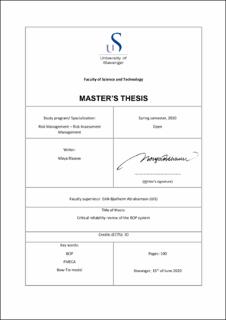| dc.description.abstract | Blow Out Preventer, often referred to as BOP, is an important tool in drilling operation in the Oil and Gas industry. It is also one of the most important tools to secure the safety of drilling operations. Once a BOP system failure occurs, it is necessary to perform maintenance of the BOP system, which will lead a certain downtime and millions of financial losses. A BOP system failure could also in worst case lead to a blow out, which could lead to catastrophic consequences beyond our ability to estimate, with huge financial, health and environmental and reputational losses. Thus, reliability research is necessary in the risk analysis of the BOP.
Reliability research includes reliability analysis and reliability calculation that both needs to be based on accurate history data. In this thesis, failure history and data are collected from many risks analysis reports and reliability research papers which are then further taken into a reliability risk analysis.
This thesis first introduces a BOP system and its structure, function and operation environment, which provides a basis for the establishment of reliability model. In order to prevent blowout incidents on offshore drilling rigs, it is important to ensure a reliable, safe and efficient operation of the BOP system. This paper introduces a combined method of FMECA method and bow-tie risk analysis model to analyse the causes and consequences of a BOP system failure. All possible failure modes of the BOP system and equipment are first defined, then the failure modes are sorted and analysed. The most harmful or serious failure modes is then determined.
For system failures modes with serious consequences, a bow-tie analysis model is implemented to find all the causes of failures including human factors. A summary is given to go over the five main failure reasons and is finally concluded with some further improvement suggestions.
Based on the structure and function of the BOP system, a reliability allocation model is established and simplified. By using the analytic hierarchy process, the reliability index of the system is allocated to each of the equipment. A fault tree analysis is used to complete the reliability prediction of the overall BOP system. According to the reliability prediction results, the preliminary design of the BOP system meets the MTBF requirements. | en_US |
